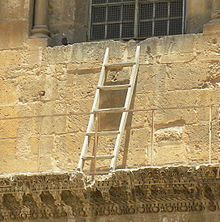
The Church of the Holy Sepulchre, also known as the Church of the Resurrection, is a church in the Christian Quarter of the Old City of Jerusalem. It is considered to be the holiest site for Christians in the world, as it has been the most important pilgrimage site for Christianity since the 4th century.
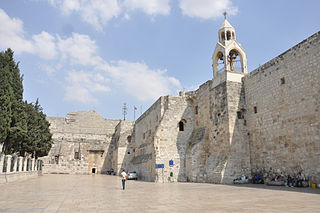
The Church of the Nativity, or Basilica of the Nativity, is a basilica located in Bethlehem in the State of Palestine, in the West Bank. The grotto holds a prominent religious significance to Christians of various denominations as the birthplace of Jesus. The grotto is the oldest site continuously used as a place of worship in Christianity, and the basilica is the oldest major church in the Holy Land.

The Latin Patriarchate of Jerusalem is the Latin Catholic ecclesiastical patriarchate in Jerusalem, officially seated in the Church of the Holy Sepulchre. It was originally established in 1099, with the Kingdom of Jerusalem encompassing the territories in the Holy Land newly conquered by the First Crusade. From 1374 to 1847 it was a titular see, with the patriarchs of Jerusalem being based at the Basilica di San Lorenzo fuori le Mura in Rome. Pope Pius IX re-established a resident Latin patriarch in 1847.
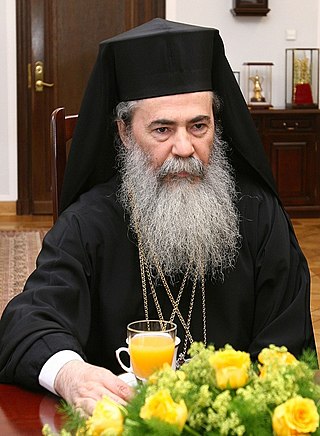
The Greek Orthodox Patriarch of Jerusalem or Eastern Orthodox Patriarch of Jerusalem, officially Patriarch of Jerusalem, is the head bishop of the Greek Orthodox Patriarchate of Jerusalem, ranking fourth of nine Patriarchs in the Eastern Orthodox Church. Since 2005, the Eastern Orthodox Patriarch of Jerusalem has been Theophilos III. The Patriarch is styled "Patriarch of the Holy City of Jerusalem and all Holy Land, Syria, beyond the Jordan River, Cana of Galilee, and Holy Zion." The Patriarch is the head of the Brotherhood of the Holy Sepulchre, and the religious leader of about 130,000 Eastern Orthodox Christians in the Holy Land, most of them Palestinians.

The Greek Orthodox Patriarchate of Jerusalem, also known as the Greek Orthodox Church of Jerusalem, is an autocephalous church within the wider communion of Eastern Orthodox Christianity. Established in the mid-fifth century as one of the oldest patriarchates in Christendom, it is headquartered in the Church of the Holy Sepulchre in Jerusalem and led by the Patriarch of Jerusalem, currently Theophilos III. The Patriarchate's ecclesiastical jurisdiction includes roughly 200,000 to 500,000 Orthodox Christians across the Holy Land in Palestine, Jordan and Israel.
Emmanouil Skopelitis was, under the name Irenaios, the 140th patriarch of the Greek Orthodox Church of Jerusalem, from his election in 2001, when he succeeded Patriarch Diodoros, until his dismissal in 2005, when he was succeeded by Patriarch Theophilos III.

Sep. 12 - Eastern Orthodox liturgical calendar - Sep. 14

The Catholic Church in Israel is part of the worldwide Catholic Church, in full communion with the Holy See in Rome. The Catholic Church in Israel is divided into three main jurisdictions: the Latin Patriarchate of Jerusalem, the Franciscan Custody of the Holy Land, and the Salesian Mission. Each of these jurisdictions has its own responsibilities and areas of operation.

Jerusalem's role in first-century Christianity, during the ministry of Jesus and the Apostolic Age, as recorded in the New Testament, gives it great importance. Jerusalem is generally considered the cradle of Christianity.

Eastern Christian monasticism is the life followed by monks and nuns of the Eastern Orthodox Church, Oriental Orthodoxy, the Church of the East and Eastern Catholicism. Eastern monasticism is founded on the Rule of St Basil and is sometimes thus referred to as Basilian.

The Custody of the Holy Land is a custodian priory of the Order of Friars Minor in Jerusalem, founded as the Province of the Holy Land in 1217 by Saint Francis of Assisi, who had also founded the Franciscan Order in 1209. In 1342, the Franciscans were declared by two papal bulls as the official custodians of the Holy Places in the name of the Catholic Church.

The Armenian Patriarchate of Jerusalem, also known as the Armenian Patriarchate of Saint James, is located in the Armenian Quarter of Jerusalem. The Armenian Apostolic Church is officially recognised under Israel's confessional system, for the self-regulation of status issues, such as marriage and divorce.

Patriarch Benedict of Jerusalem, also Benediktos I of Jerusalem, born Vasileios Papadopoulos was the Patriarch of Jerusalem of the Greek Orthodox Church of Jerusalem from 1957 to 1980.
Theoleptus I, was Ecumenical Patriarch of Constantinople from 1513 to 1522.

The Status Quo is an understanding among religious communities with respect to nine shared religious sites in Jerusalem and Bethlehem. Other Holy Places in Israel and Palestine were not deemed subject to the Status Quo, because the authorities of one religion or community within a religion are in recognized or effective possession of them.

Deir es-Sultan, literally the Monastery of the Sultan, is a monastery located on the roof of the Chapel of Saint Helena, which is part of the Church of the Holy Sepulchre in Jerusalem's Old City. The Status Quo, a 250-year old understanding between religious communities, applies to the site.
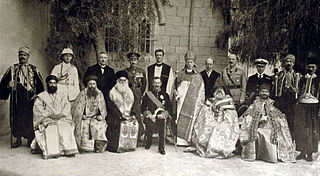
The Holy and Ancient Archdiocese of Jerusalem, All Palestine, and All the Near East or the Coptic Orthodox Patriarchate in Jerusalem, is a Metropolitan Archdiocese of the Coptic Orthodox Church, which is part of the wider communion of the Oriental Orthodox Church. It is headed by the Coptic Orthodox Metropolitan Archbishop of Jerusalem, the incumbent being Metropolitan Archbishop Antonious of Jerusalem since 2016. Its jurisdiction covers those Coptic Orthodox Christians living in the Near East; with churches and monasteries in the State of Palestine, the State of Kuwait, the Hashemite Kingdom of Jordan, the Lebanese Republic, the Syrian Arab Republic, and the Republic of Iraq. The adherents are largely of Coptic Egyptian descent, mainland Coptic migrants and their descendants. The archdiocese is based at St Anthony's Monastery, in the Christian Quarter of the Old City of Jerusalem, beside the Church of the Holy Sepulchre.
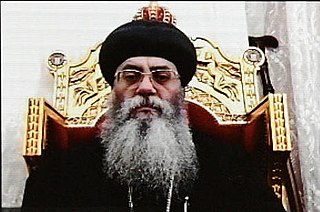
Antonius, is the 22nd Metropolitan of the Holy and Great City of Our Lord, Jerusalem, and Archbishop of the Holy and Ancient Archdiocese of Jerusalem, all Palestine and the Near East. He is also the Abbot of the Monastery of Saint Anthony, Jerusalem, and the Monastery of Saint George, Jerusalem.
The Monastery of the Archangels Michael and Gabriel was founded and raised in 1312 in Jerusalem by King Milutin. It is located within the walls of the Old City of Jerusalem, near the Church of the Holy Sepulcher and the Greek Patriarchate.

